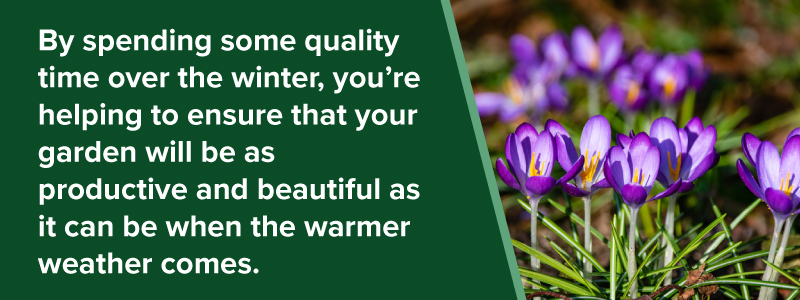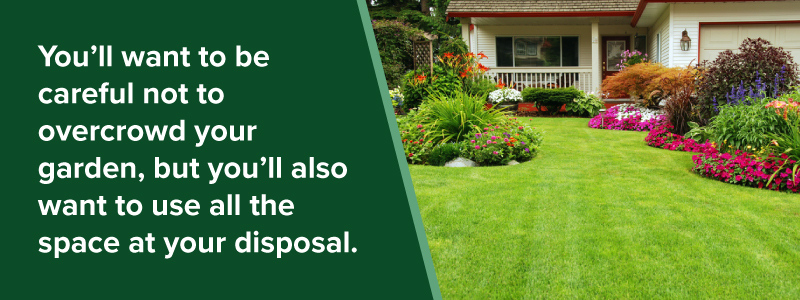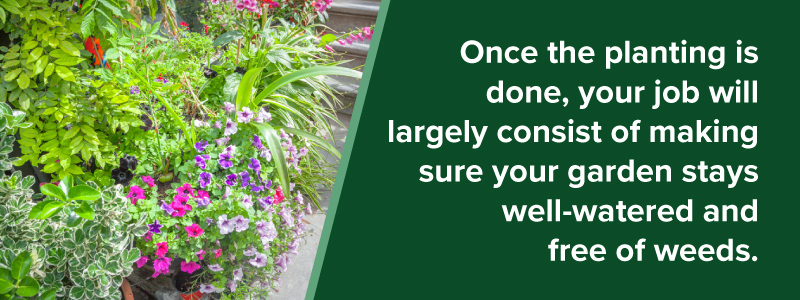
How to Plan Out Your Spring Garden
Even if the weather outside is still cold and wintry, don’t let that fool you. Spring is just around the corner! That means it’s time to start thinking about warmer temperatures, open windows and longer spring nights. More specifically, it means it’s time to start planning a spring landscape.
No, you won’t be able to start planting just yet. The ground will still be too cold and the nights will get too chilly for several more weeks. But now is the time to start planning. Use these last few weeks of cold weather to formulate a plan of action for your landscape. That way, when spring finally does arrive in earnest, you’ll be ready to get off on your best foot with your garden.
If gardening is still fairly new to you, however, sometimes it can be hard to know how to plan a spring garden. What types of things do you need to be thinking about? When can you start planning? What needs to be done before then?
Today, we want to answer these questions and more. To help your yard and landscape be the best it can be this year, we’ve compiled a list of tips for planning your spring garden. It doesn’t matter if you’re dealing with a vegetable garden, a flower bed or a sweeping landscape of perennials. By following these ideas, your garden will be bursting with color and greenery in no time.
Why Should You Plan for Your Garden Ahead of Time?
You might wonder why it’s necessary to plan your garden ahead of time. After all, if you can’t plant yet — so what's the point of spending time thinking about it?
But the truth is, if you don’t invest a little bit of time planning, you’re very likely to miss planting season altogether. And even if you do manage to plant a garden, it will likely be a bit more scattered and haphazard than if you had taken the time to plan it out carefully. By spending some quality time over the winter, you’re helping to ensure that your garden will be as productive and beautiful as it can possibly be when the warmer weather finally does come.
Another great reason to plan ahead of time is that it can help tide you through the winter. It’s a well-known fact that winter months can seem very long and difficult to power through. The days are cold, the nights are long and we’re all tired of cleaning snow off our cars. Spending a little time thinking about the beautiful summer garden you’ll have can be just the boost you need to lift you out of the winter blues and set you on the path towards spring.

1. Review the Previous Year’s Garden
The first step to take toward the upcoming year’s garden is to take a moment to look back on last year’s garden. The biggest question you’ll want to ask yourself is this: How successful was last year’s garden?
For this question to be helpful, you’ll need to evaluate how well each type of plant grew. If you have a flower garden, you’ll want to take note of the fact that the lobelia grew extremely well while the marigolds died off after only a week. If you’re thinking about a landscape, perhaps you’ll want to remember that the ornamental grasses did poorly while the rosebushes flourished.
Whatever the result of last year’s garden, take careful note of it and review those notes now. Remember which plants did poorly last year and either avoid planting them again, or plan for a new strategy to help them succeed this year. When trying to think about what new plants you might want to experiment with this year, think about plants that require similar growing conditions to the plants that did well last year.
You can also use your experiences last year to more successfully plan the upcoming year. Ask yourself if you felt that any plants would have benefitted from being planted earlier or later. Try to remember which plants were eaten by pests and remember to buy the appropriate bug-repellent. By calling on your past experiences in this way, you will be better prepared to make this year a success.
2. Decide What to Plant
Because this is a matter of personal preference, ability and climate zone, we can’t tell you what to plant. Everyone’s garden will be unique to them. But we can give you some tips on how to decide what to plant. Here are some of the things to consider when deciding what to plant in your garden:
- What Climate Do I Live In? It goes without saying that different plants require different climates. You are not likely to have good luck if you attempt to grow tropical plants outdoors in New England, and so on.
- What Are the Growing Conditions? Specifically, what are the growing conditions in your garden? Is your garden in full sun all day long or is it shaded for half the day? Is the soil extremely rocky or is it a bit sandy?
- How Long Is My Growing Season? Some plants require a longer growing season if they’re going to be a true success. Others require only a fraction of this time. Take a good look at how long your growing season is and let that help determine your plant choices.
- How Much Space Do I Have? If you have only a very small plot of land, we don’t recommend growing large shrubs, grasses or bushes. It might be better to stick with smaller plants that stay more contained in their assigned spaces.
- What Do I Think Is Pretty? The main purpose of landscaping is to add a little extra color and beauty to your yard. Because of this, it only makes sense to plant flowers that you find beautiful to look at. For example, if you can’t stand the sight of sunflowers, ditch those and plant something you like better.
- What Is the Most Practical? Realistically, we don’t all have a limitless amount of time to spend in the garden. If you’re rarely able to attend to your garden, it might be best to shy away from any plants that require constant care and attention.

3. Decide Whether You’ll Plant Seeds or Seedlings
In many cases, you may use a combination of these two options. You may choose to start some plants directly from the seeds while with other plants you may find it more practical to work with seedlings. If you’re trying to decide between the two options, consider these two factors:
How long is your growing season? Some plants require months from the time they’re put into the ground until they’re fully blooming. If your growing season is not that long, you may need to start these plants as seedlings to get a jump start.
How easily do plants transplant? Some plants are very durable and take easily to being transplanted. Others are more fragile and you may have a more difficult time transplanting them.
Other factors to think about include price and convenience. The most convenient option, by far, is to plant seedlings. This option is easy and relatively stress-free. Planting from seeds, however, is generally much more economical.
Taking all of these factors into consideration, decide which option or which combination of these options is best for your garden or landscape.
4. Plan Out Your Space
Now that you’ve gotten these basic questions out of the way, it’s time to get down to some of the nuts-and-bolts of your garden planning. It’s time to plot out which plants you’ll plant in which locations in your garden when you’ll plant them, and so on.
For this stage, we recommend drawing up an actual diagram of your garden plot or yard. Get out a yardstick or measuring tape and p out the dimensions of your space. Then, draw an accurately scaled replica in your notebook or on a sheet of paper. We recommend using a pencil, since you’ll probably need to erase things a few times.
Next, write down the list of everything you want to plant in your garden and start experimenting with different ways to make them all fit. If you’re unsure about the adult size of any of the plants you’re planning, do a quick search to learn more about them. Learn how big they’ll grow and whether or not they spread out or stay fairly contained in their own space.
With a rough idea of what dimensions to expect from your plants, move pieces around in your diagram until you come to an arrangement that seems like it will work. You’ll want to be careful not to overcrowd your garden, but you’ll also want to use all the space at your disposal.

5. Make a Planting Schedule
Now that you have a firm grasp of all the plants you’re going to grow this year, it’s time to plan when you’ll plant each of them. For that, you’ll need to know when the last frost is. This date estimate should be readily available by looking up your local weather and forecast information.
Arm yourself with information about how much time each one of the plants you’re adding to your garden needs to grow. Some seeds or seedlings might need to be planted as soon as possible while others can easily wait until later in the spring. Each plant will be different, so you’ll need to conduct research on your plants to learn more about them.
Once you have all this information, it’s a good idea to label your landscape diagram with the dates you’ve designated as planting days. After that, the important thing is to stick to these dates.
6. Order Your Seeds and Supplies
It’s a good idea to do this ahead of time. If you wait until planting time to buy your seeds, you’re setting yourself up for difficulty. The stores may already be sold out of seeds by this time. And if you order the seeds online, it will take days or even weeks for them to arrive. By the time they get to you, your carefully planned planting schedule may already be thrown off.
To avoid this, order your seeds far in advance. This way, you’ll have plenty of time to spare and the seeds will be ready when it’s time to plant. Sometimes, certain companies may even offer discounts if you buy your seeds early enough.
While you’re already buying your seeds, this is also the perfect time to stock up any other garden supplies you may need for the upcoming season. This might include things like spades and trowels, mulch, insect repellents, special plant nutrients or supplements, or even some decorative ornaments for your flower beds.
Whatever it is that you need, now is the time to stock up.

What Should You Expect When Spring Comes?
If you spend the winter and very early spring planning, this work should be out of the way by the time spring finally rolls around. This means you can spend your spring putting in the work that it will take to make your garden bloom and thrive.
One of the first big tasks you’ll face is cleaning. Most likely, the winter will have wreaked havoc on your yard. You’ll need to do things like rake up the dead leaves and other debris that might be covering your grass and flowerbeds. You may also need to do things like pull up dead stalks from last year and clear away the last of the old annuals. You’ll want to rake up dead grass and remove any rocks or gravel that may have ended up in the yard. Once this is done, you’ll be all ready for some spring garden planting.
On the days that you’ve already established, plant your garden. Whether you’re dealing with seeds or seedlings, it’s time to get them in the ground and let them start germinating and growing.
Once the planting is done, your job will largely consist of making sure your garden stays well-watered and free of weeds. Be especially careful that you know what your plant sprouts look like, so you don’t accidentally pull them up while weeding. By keeping your garden weeded and watered, you’re giving your plants their best shot at a long and fruitful growing season.
Buy Your Garden Supplies From Garden Goods Direct and Start Planning Your Landscape Today
With spring nearly upon us, it’s almost time to put all that planning to good use. But before you can get planting, you’ll need some supplies.
Here at Garden Goods Direct, we’re your one-stop shop for all your gardening needs. If you need shrubs, perennials or ornamental grasses for your landscaping, we’ve got those. If you’re looking for smaller annuals for a little flower bed, we’ve got those too. Are you in need of supplies like gardening gloves, rakes, fences or animal repellents? We’ve got those and so much more.
We want to help you get your spring garden off on the right foot. Browse our full catalog of perennials today to get started! If you have any questions at all, please don’t hesitate to call us at 1-844-348-8971.
